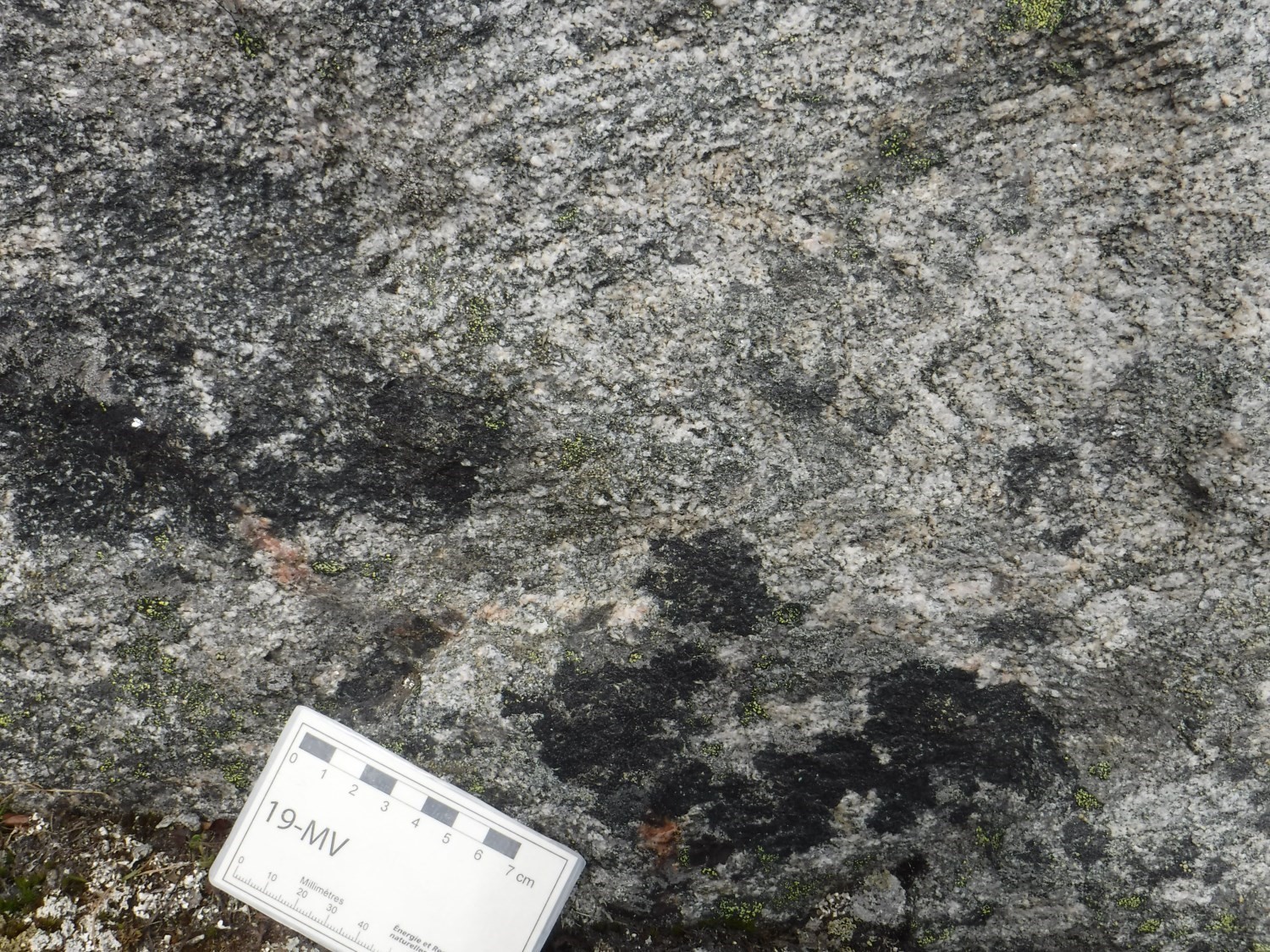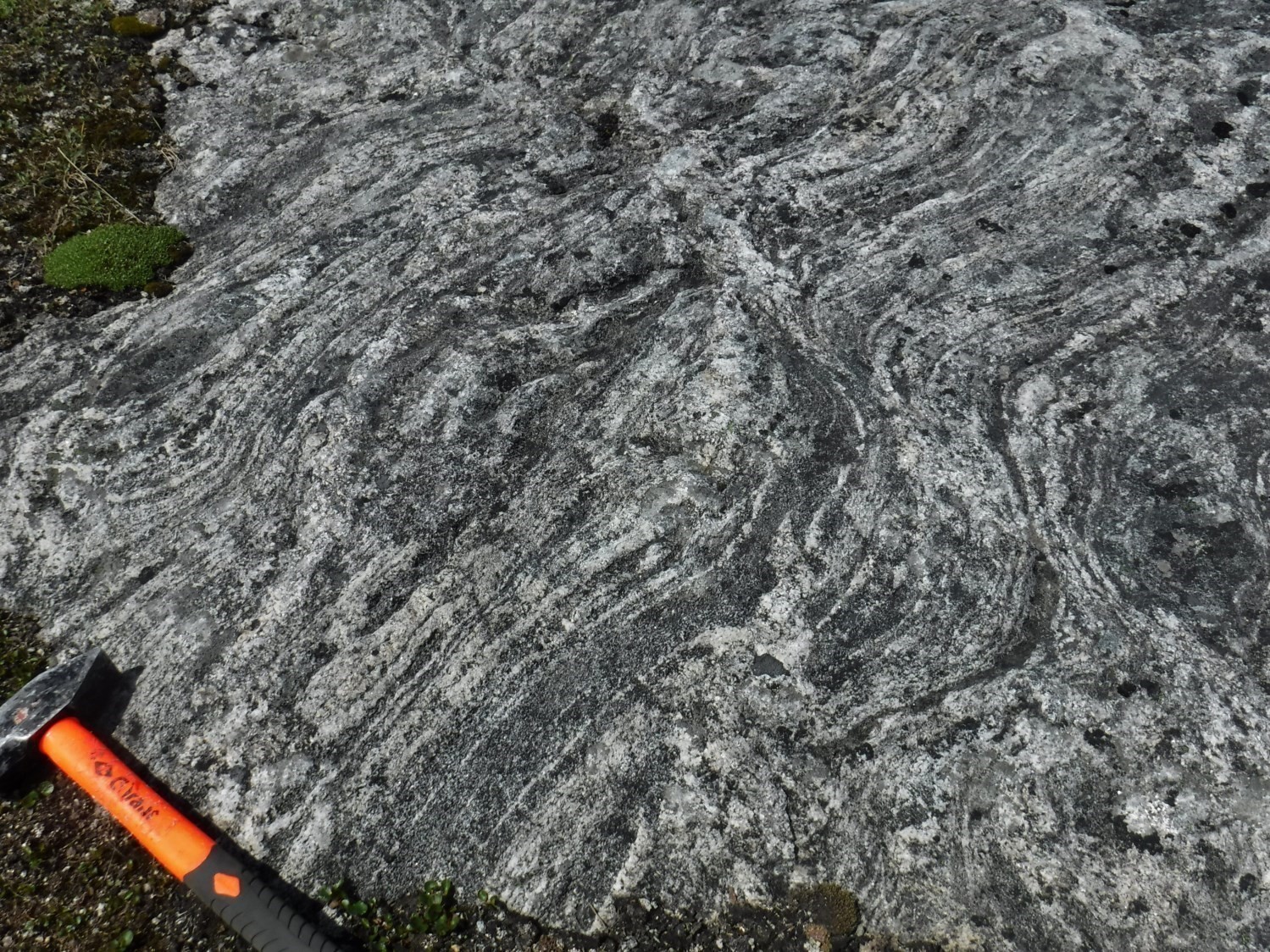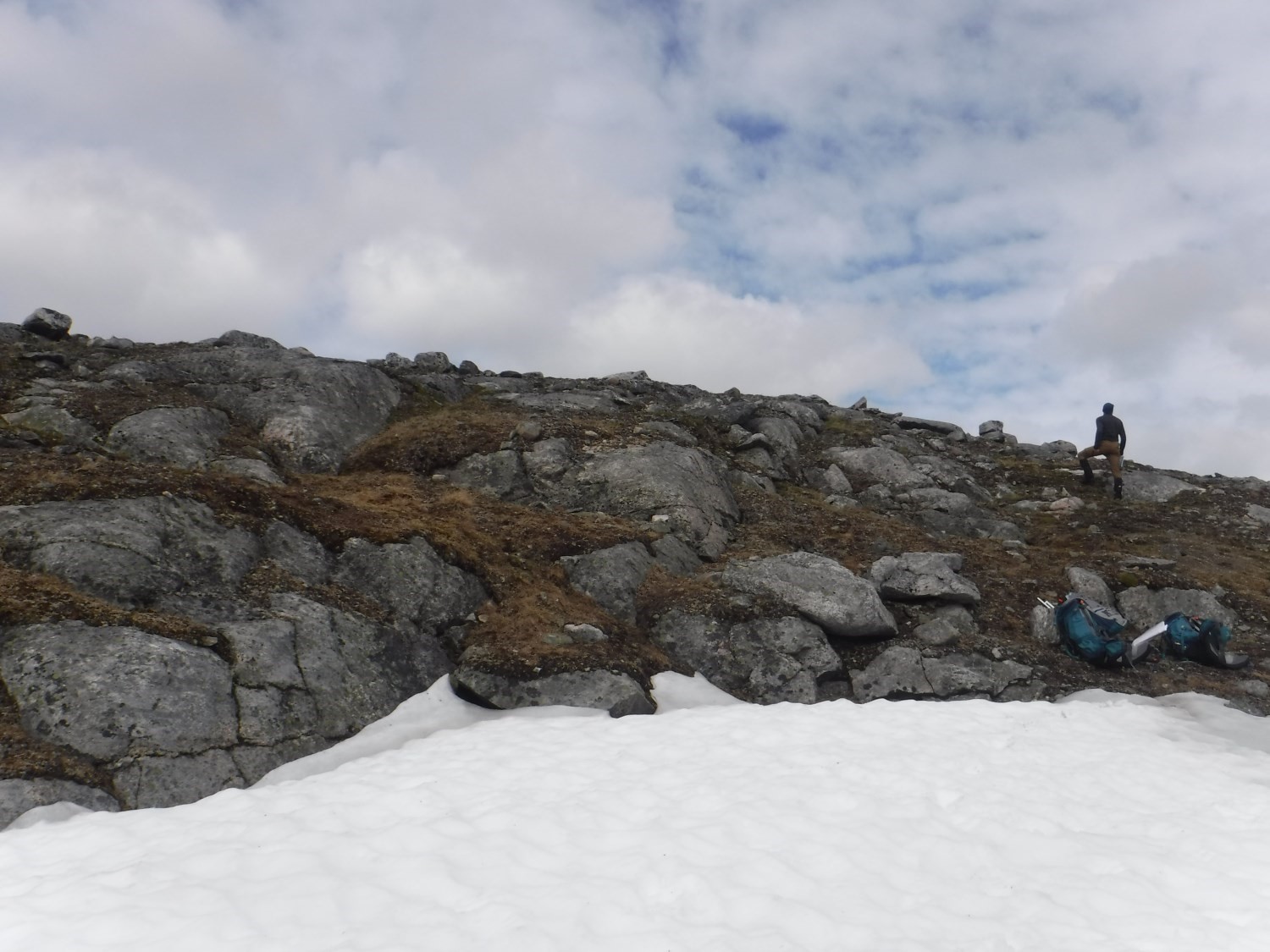
| Author(s) | Vanier and Lafrance, 2020 |
| Methodology | Defined from geological survey and geophysical data |
| Geological(s) subdivision(s) | Churchill Province / Ungava Orogen / Narsajuaq Lithotectonic Domain |
| Main movement | Does not apply |
| Deformation style | Dome (possibly formed by vertical displacement in medium crust condition) |
| Metamorphic facies (mean facies related to main deformation) | Upper amphibolites |
Background and Methodology
This record is based on aeromagnetic maps’ interpretation (Intissar et al., 2014) and information collected from geological survey carried out in the summer of 2019 in the Sirmiq Lake area (Vanier and Lafrance, 2020).
Boundaries and Morphology
| Width | ~12 km |
| Length | ~25 km |
| Orientation | Elongated ellipse along a N-S axis |
Direct and indirect observations made it possible to define the extent of the Routhier Structural Domain (DSrou). Firstly, foliation measurements compatible with a structural dome elongated along a N-S axis were integrated into this domain. Between these direct and local information, the geophysical pattern was used, since almost the entire dome is marked by concentric aeromagnetic lineaments forming an ellipse. The DSsrou forms an elliptical dome ~12 km by ~25 km. It is bordered by the Sources, Kuuruq and Siukkaq structural domains to the west, SE, and east respectively. Shear zones having indeterminate movement and moderate dip are presumed to delineate the dome; however, they have not been directly observed.
Stratigraphic Units Concerned
The DSrou is mainly composed of rocks of the Sainte-Hélène Complex. Some klippes of the Pingasualuit Complex and Kuugaq Suite are also present, as well as late granitic rock masses of the Sannigajualuk Suite.
Structural Characteristics
❯ Main Fabrics
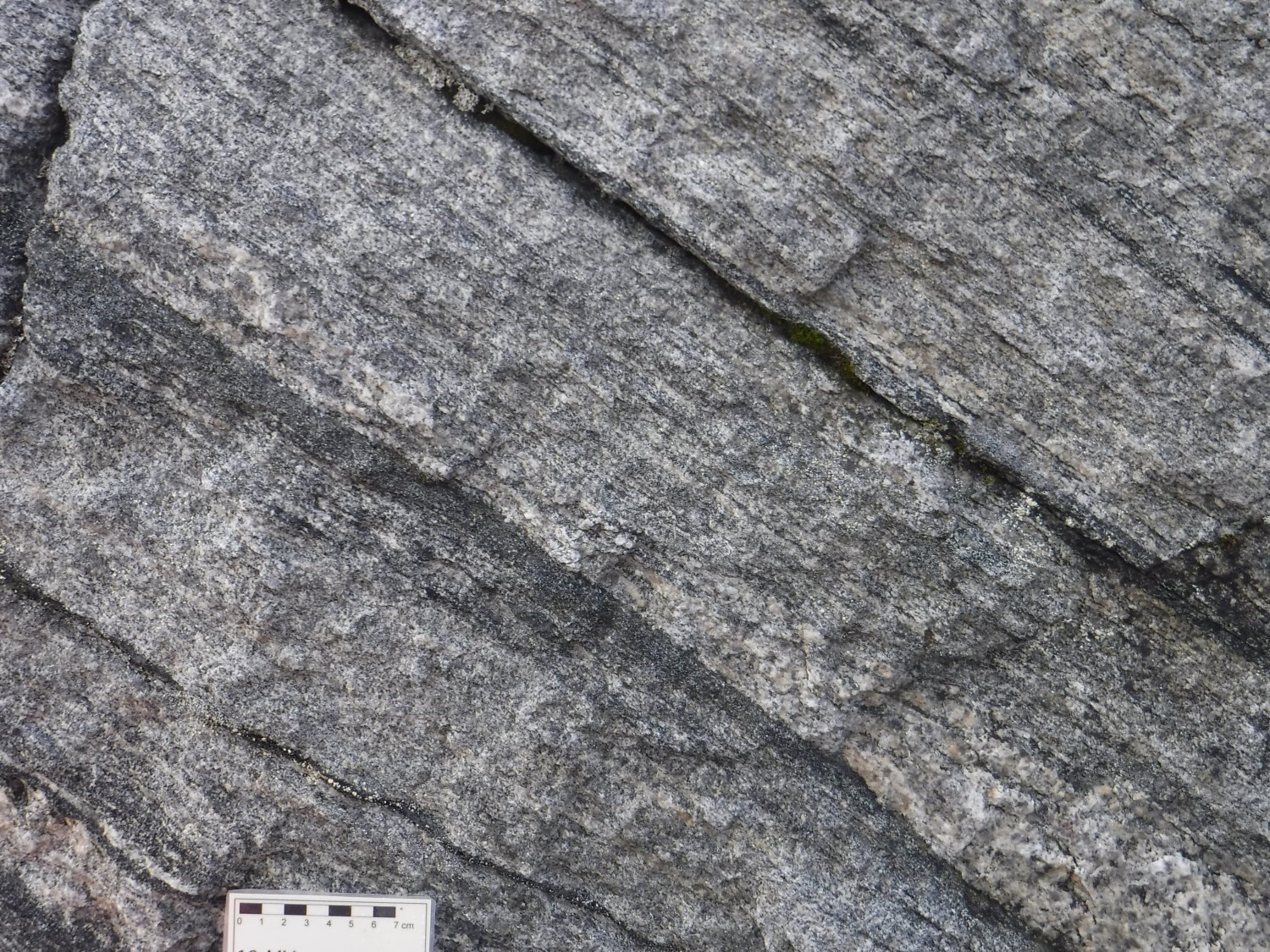
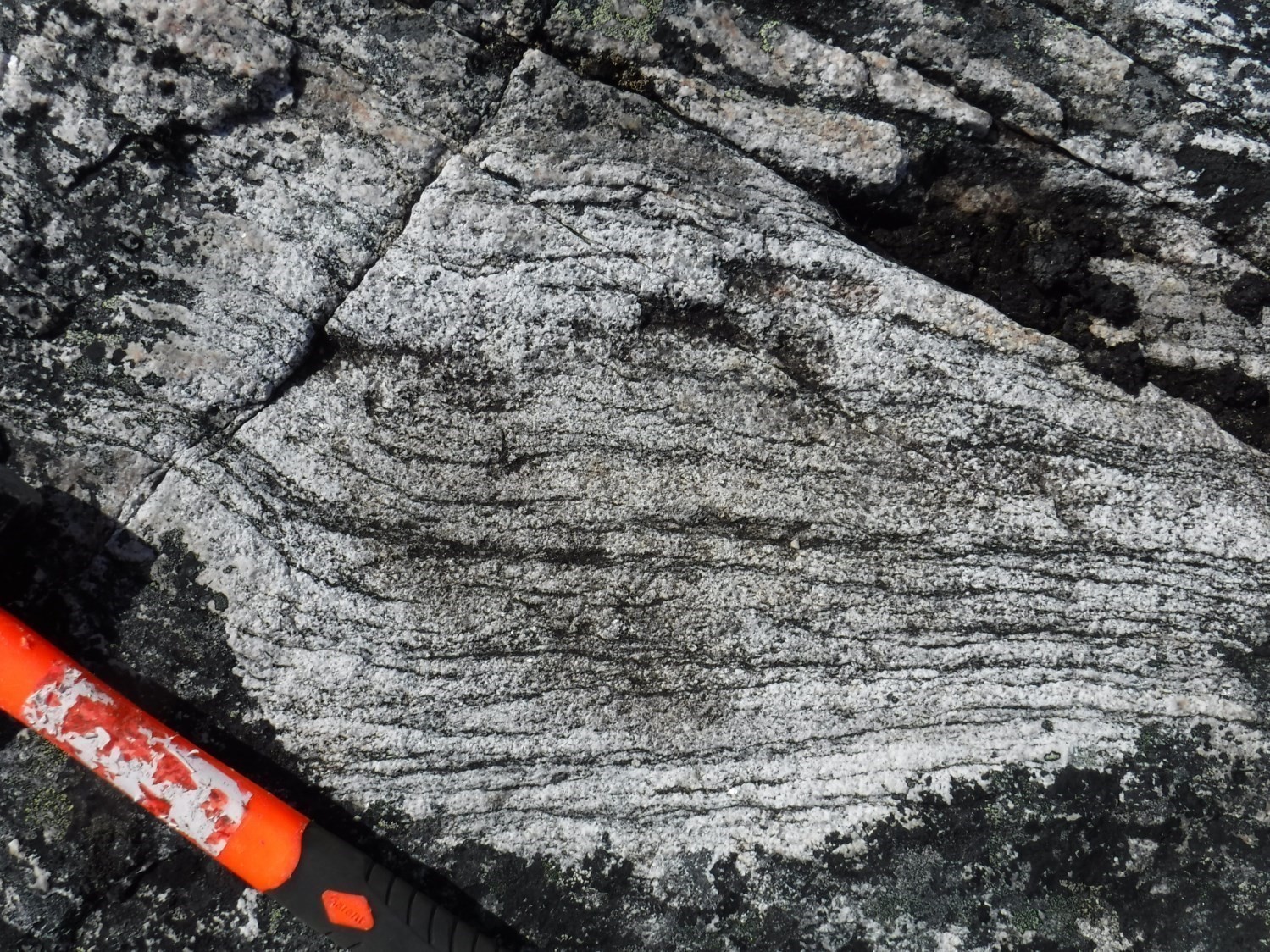 Linear and planar fabrics of the DSrou have a very variable orientation, reflecting both the domed geometry and the presence of some highly migmatized areas. Overall, the foliation and gneissosity’s dip is shallow to moderate (<50°). The same applies to the inclination of lineations which is generally low, commonly <40°. Generally, foliation and gneissosity are straight and regular.
Linear and planar fabrics of the DSrou have a very variable orientation, reflecting both the domed geometry and the presence of some highly migmatized areas. Overall, the foliation and gneissosity’s dip is shallow to moderate (<50°). The same applies to the inclination of lineations which is generally low, commonly <40°. Generally, foliation and gneissosity are straight and regular.
In banded or migmatitic rocks, foliation is accompanied by stromatic or compositional banding mainly defined by grain size and mineralogical variations. Schlierens and melanosome klippes define a planar fabric more irregular than foliation or gneissosity. In areas where partial melting is more advanced, these structures give a creep appearance to the rock.
| Main Fabric | Type of Fabric | Direction (°) | Dip / Plunge (°) | Number of Measurements | Comments |
| Foliation Sn | Tectonometamorphic foliation and gneissosity | Variable | Variable | 63 | Mostly <50° and of variable orientation |
| Lineation Ln | Stretch and mineral lineation | Variable | Variable | 12 |
❯ Other Fabrics
Not observed.
❯ Folds
On some outcrops, the foliation is folded by wide (amplitude >10 m) or compressed (decimetric) folds. The former are commonly visible in areas where foliation is subhorizontal. Fold observations do not currently allow any organized pattern to be defined.
❯ Crosscutting Relationships
None.
❯ Kinematics
Does not apply.
Deformation Style
The DSrou is a dome consisting mainly of dioritic to tonalitic orthogneiss. The shape of the dome is that of an ellipse whose long axis is N-S oriented. This shape is clearly defined by aeromagnetic lineaments and foliation traces. The intensity of deformation is homogeneous and corresponds to a regular foliation or gneissosity usually consistent between outcrops. However, in areas where foliation is very slightly inclined (<20°), the orientation is variable and disordered in appearance.
Metamorphic Characteristics
The dominant unit of the DSrou is the Saint-Hélène Complex, which has abundant textures indicative of partial melting such as stromatic banding and various neosomes. Deformation is usually less significant in rocks that have undergone a high partial melting rate than in rocks that appear to be poorly or not migmatized. This indicates that deformation is concomitant with migmatization, so rocks containing high mobilisate contents have recorded less deformation. Stromatic textures form when deformation is simultaneous with anatectic conditions (Sawyer, 2008). Thus, the upper amphibolite facies metamorphic event that caused migmatization of the Sainte-Hélène Complex is also associated with the main deformation.
Petrographic descriptions support high temperature conditions during deformation. Indeed, quartz commonly developed a lenticular arrangement of interlobed to amoeboid grains as well as pinch textures, which indicate dynamic recrystallization by grain edge migration (Guillope and Poirier, 1979; Urai et al., 1986; Jessel, 1987). This quartz recrystallization mechanism is active at >500°C (Kruhl, 1998; Stipp et al., 2002).
Alterations
Not observed.
Geophysical Characteristics
At the periphery of the DSrou, alternating positive aeromagnetic ridges define ellipses that allow to visualise the general geometry of the dome (Intissar et al., 2014). In the centre, the DSrou has a diffuse aeromagnetic signature that reflects the shallowly dipping geological structures and contacts, which cause little variation in aeromagnetic properties in the horizontal plane.
Chronological Markers
Deformation in the DSrou mainly affects the Sainte-Hélène Complex, which is of Archean age and which underwent a partial melting event concomitant with the main deformation. There is currently no known metamorphic age in the Sainte-Hélène Complex. However, this episode is likely close to the age of other complexes and suites of the Narsajuaq Lithotectonic Domain, from 1880 Ma to 1806 Ma (Davis and Sutcliffe, 2019; Vanier and Lafrance, 2020), this age range is currently the best estimate for a synkinematic age. The best approximation for a minimum age corresponds to the intrusion of granitic dykes related to the Sannigajualuk Suite at ~1800 Ma (Parrish, personal communication, 1994), since these cut the main fabric in the DSrou.
References
Publications Available Through Sigéom Examine
DAVIS, D. W., SUTCLIFFE, C.N., 2018. U-Pb Geochronology of Zircon and Monazite by LA-ICPMS in Samples from Northern Quebec. University of Toronto. MB 2019-01, 113 pages.
INTISSAR, R., BENAHMED, S., D’AMOURS, I. 2014. Levé magnétique et spectrométrique aéroporté de la partie nord de l’Orogène de l’Ungava, Province de Churchill. MRN. DP 2014-03, 10 pages and 410 plans.
VANIER, M.-A., LAFRANCE, I., 2019. Géologie de la région du lac Sirmiq, Orogène de l’Ungava, Nunavik, Québec, Canada. MERN. BG 2020-02, 1 plan.
Other Publications
GUILLOPE, M., POIRIER, J.P., 1979. Dynamic recristallization during creep of single crystaline halite: an experimental study. Journal of Geophysic Research; volume 84, pages 5557-5567. doi.org/10.1029/JB084iB10p05557
HIRTH, G., TILLIS, J., 1992. Dislocation creep regimes in quartz aggregates. Journal of Structural Geology; volume 14, pages 145–159. doi.org/10.1016/0191-8141(92)90053-Y
JESSELL, M.W., 1987. Grain-boundary migration microstructures in a naturally deformed quartzite. Journal of Structural Geology; volume 9, pages 1007–1014. doi.org/10.1016/0191-8141(87)90008-3
KRUHL, J.H., 1996. Prism- and basal-plane parallel subgrain boundaries in quartz: a microstructural geothermobarometer. Journal of Metamorphic Geology; volume 14, pages 581-589. doi.org/10.1046/j.1525-1314.1996.00413.x
SAWYER, E.W., 2008. Atlas of migmatites. NRC Research press, 2008. 371 pages.
STIPP, M., STÜNIZ, H., HEILBRONNER, R., SCHMID, S.M., 2002. The eastern Tonale fault zone: a natural laboratory for crystal plastic deformation of quartz over a temperature range from 250 to 700 °C. Journal of Structural Geology; volume 24, pages 1861-1884. doi.org/10.1016/S0191-8141(02)00035-4
URAI, J.L., MEANS, W.D., LISTER, G.S., 1986. Dynamic recrystallization of minerals. Mineral Rock Deformation Laboratory Studies; volume 36, pages 161-199.
Suggested Citation
Ministère de l’Énergie et des Ressources naturelles (MERN). Routhier Structural Domain. Quebec Structural Lexicon. https://gq.mines.gouv.qc.ca/lexique-structural/domaine-structural-de-routhier_en/ [accessed on Day Month Year].
Contributors
|
First publication |
Marc-Antoine Vanier, Jr. Eng., M.Sc. marc-antoine.vanier@mern.gouv.qc.ca; Isabelle Lafrance, P. Geo., M.Sc. isabelle.lafrance@mern.gouv.qc.ca (redaction); Ghyslain Roy, P. Geo. (coordination); James Moorhead, P. Geo., M.Sc. (critical review); Simon Auclair, P. Geo., M.Sc. (editing); André Tremblay (HTML editing); Céline Dupuis, P. Geo., Ph.D. (English version) |


